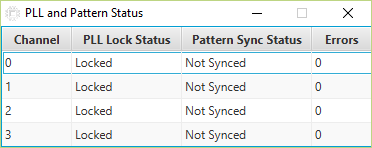Visible to Intel only — GUID: ugl1491954228043
Ixiasoft
6.3.1. The Configure Menu
6.3.2. The System Info Tab
6.3.3. The GPIO Tab
6.3.4. The Flash Tab
6.3.5. The FMCA Tab
6.3.6. The FMCB Tab
6.3.7. The LPBK Tab
6.3.8. The MXP Tab
6.3.9. The SMA Tab
6.3.10. The QSFP and SFP+ Tab
6.3.11. The CFP4 Tab
Status
Port
PMA Setting
Data Type
Error Control
Run Control
6.3.12. Power Monitor
6.3.13. Clock Controller
Visible to Intel only — GUID: ugl1491954228043
Ixiasoft
6.3.11. The CFP4 Tab
Figure 33. The CFP4 Tab


The following sections describe controls on the CFP4 tab.
Status
The Status control displays the following status information during the loopback test:
- PLL lock: Shows the PLL locked or unlocked state
- Pattern Sync: Shows the pattern synced or not state. The pattern is considered synced when the start of the data sequence is detected.
- Details: Shows the PLL lock and pattern sync status.

Port
Use the following controls to select an interface to apply PMA settings, data type and error control:
- CFP4 x4
PMA Setting
Allows you to make changes to the PMA parameters that affect the active transceiver interface. The following settings are available for analysis:
- Serial Loopback: Routes signals between the transmitter and the receiver.
- VOD: Specifies the voltage output differential of the transmitter buffer.
- Pre-emphasis tap:
- 1st pre: Specifies the amount of pre-emphasis on the pre-tap of the transmitter buffer.
- 2nd pre: Specifies the amount of pre-emphasis on the second pre-tap of the transmitter buffer.
- 1st post: Specifies the amount of pre-emphasis on the first post tap of the trasnmitter buffer.
- 2nd post: Specifies the amount of pre-emphasis on the second post tap of the transmitter buffer.
- Equalizer: Specifies the AC gain setting for the receiver equalizer in four stage mode.
- DC Gain: Specifies the DC Gain setting for the receiver equalizer in four stage mode.
- VGA: Specifies the VGA gain value.
Figure 34. PMA Setting


Data Type
The Data Type control specifies the type of data pattern contained in the transactions. Select the following available data types for analysis:
- PRBS: pseudo-random 7-bit sequences (default)
- PRBS15: pseudo-random 15-bit sequences
- PRBS23: pseudo-random 23-bit sequences
- PRBS31: pseudo-random 31-bit sequences
- HF: highest frequency divide-by-2 data pattern 10101010
- LF: lowest frequency divide by 33 data pattern
Settings Hf and LF are for transmit observation only and are not intended for use in the receiver data detection circuits.
Error Control
This control displays data errors detected during analysis and allows you to insert errors:
- Detected Errors: Displays the number of data errors detected in the received bit stream.
- Inserted Errrors: Displays the number of errors inserted into the transmit data stream.
- Insert Error: Insert a one-word error into the transmit data stream each time you click the button. Insert Error is only enabled during transaction performance analysis.
- Clear: Resets the Detected Errors counter and Inserted Errors counter to zeros.
Run Control
TX and RX performance bars: Show the percentage of maximum theoretical data rate that the requested transactions are able to achieve.
Start: This control initiates the loopback tests.
Data Rate (H-Tile): Displays the XCVR type and data rate of each channel.
Figure 35. CFP4 Data Rate


Tx (Mbps) and Rx (Mbps): Show the number of bytes of data analyzed per second.